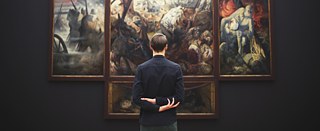The Elite in the Arts | Literature
China Literature: On Crowds and Power

For questions on the function of elites and their relationship to society as a whole, European-American literature on China is of signifying importance: It largely deals with the organization of seemingly absolute power, groups of rigorously educated officials, exceptional scholars, dramatic elite overthrows and potent crowds.
The chart tracks the popularity of China literature in terms of the breadth of its social appeal. The related trend changes during the twentieth century’s first half cycled in quick succession.


For decades after the founding of the People’s Republic, Chinese scenarios formed part of a highly specialized, socio-theoretical debate. Radical voices critical of elites demanding revolutionary pedagogical “self-education of the masses” in the Kursbuch periodical contributed as much to this discussion as did warnings by the hierarchy- and privilege-conscious top diplomat Erwin Wickert against humanity-devouring anarchy. China novels like Wickert’s The Heavenly Mandate and Tilman Spengler’s The Painter of Beijing supplemented these authors’ non-fiction works on China by providing historical case studies on the rise and fall of power, competition among elites and Pied Piperism. They kept alive a literary field that, since the cosmopolitan euphoria of the 1990s and the crises of liberal democracy, has gained again in popularity as an especially pellucid vehicle for designs of social order.
Examples of China Literature
Examples 1:Karl May: And Peace on Earth! (original: Et in terra pax,exp., 1901; original: Und Friede auf Erden! 1904)
Elisabeth von Heyking: The Letters Which Never Reached Him (1904; original: Briefe, die ihn nicht erreichten. 1902/03)
Examples 2:
Alfred Döblin: The Three Leaps of Wang Lun: A Chinese Novel (1991; original: Die drei Sprünge des Wang-lun,1916,)
Franz Kafka: The Great Wall of China (1933; original: Beim Bau der Chinesischen Mauer; 1917)
Examples 3:
Pearl S. Buck: The Good Earth (1931; German: 1933 as Die gute Erde. Roman des chinesischen Menschen; filmed 1937; Nobel Prize for Literature 1938)
Vicki Baum: Shanghai '37 (1939; German: 1939 as Hotel Shanghai)
Bertolt Brecht: Legend of the Origin of the Book Tao-te-ching on Lao tse’s Road to Exile (1976; original: Legende von der Entstehung des Buches Taoteking auf dem Weg des Laotse in die Emigration, 1939)
Examples 4:
Erwin Wickert: The Heavenly Mandate (1961; original: Der Auftrag; English, 1964; exp. 1979 as Der Auftrag des Himmels. Ein Roman aus dem kaiserlichen China)
Tilman Spengler: The Painter of Beijing (original: Der Maler von Peking,1993)
To the Overview